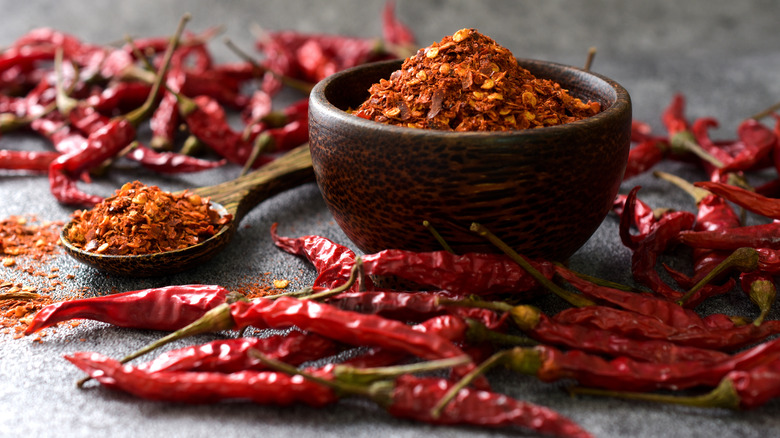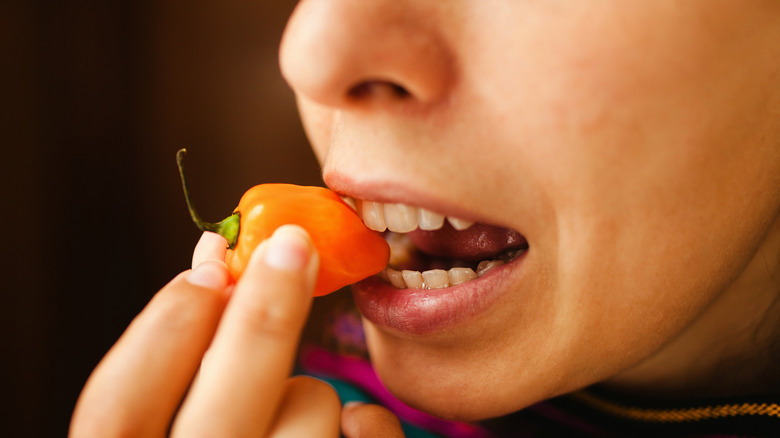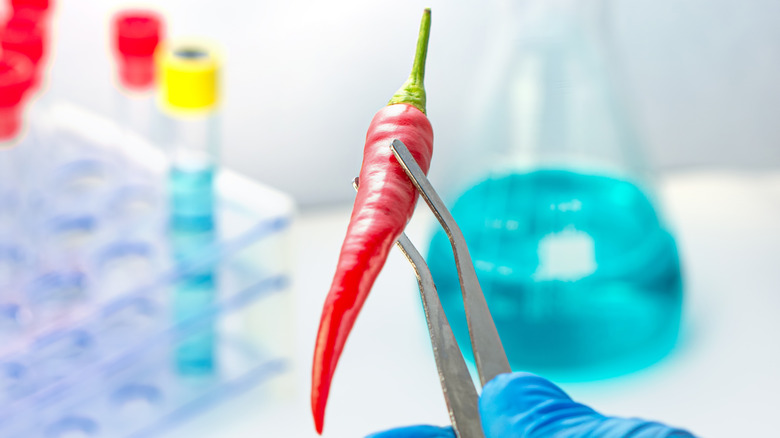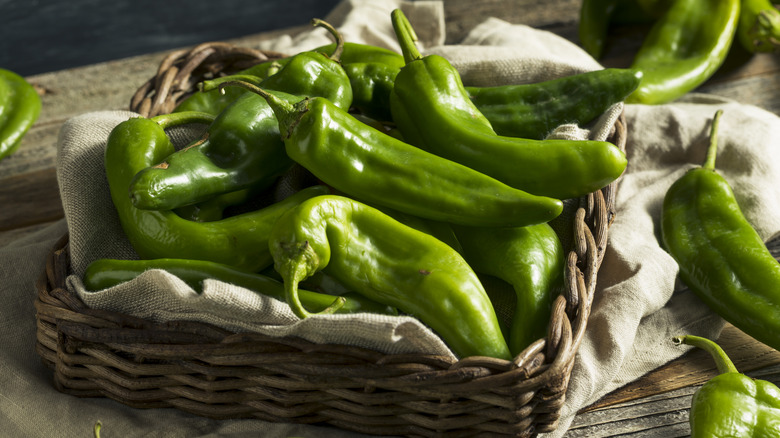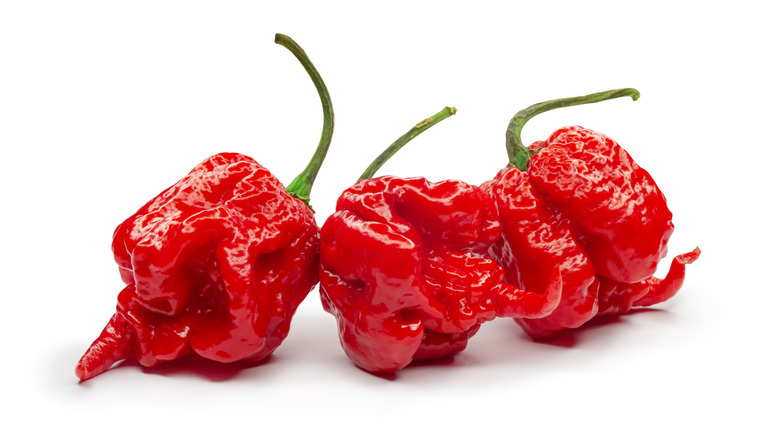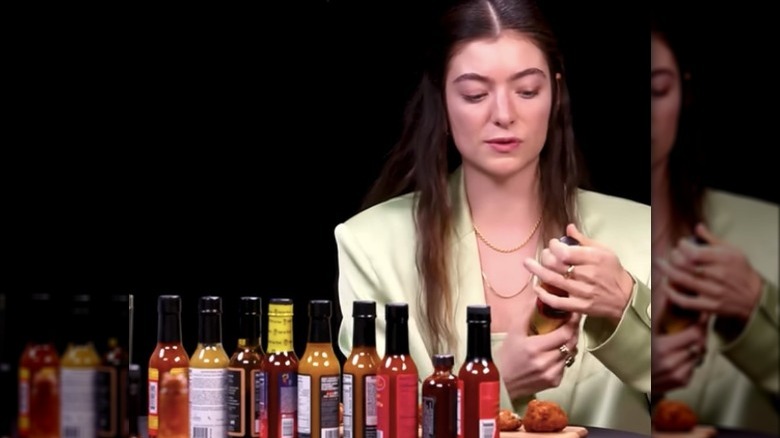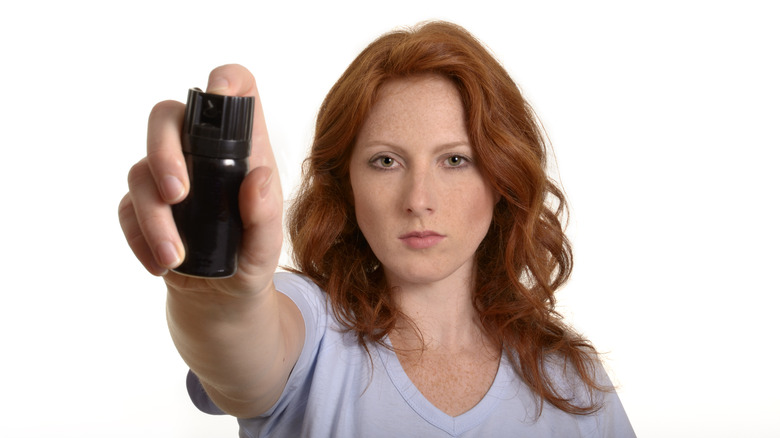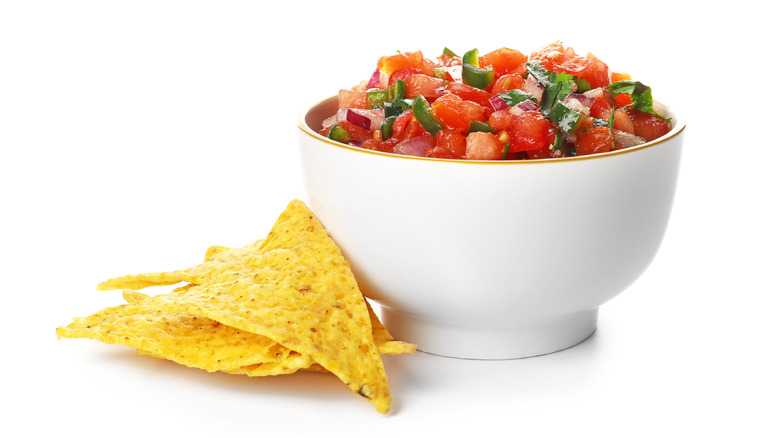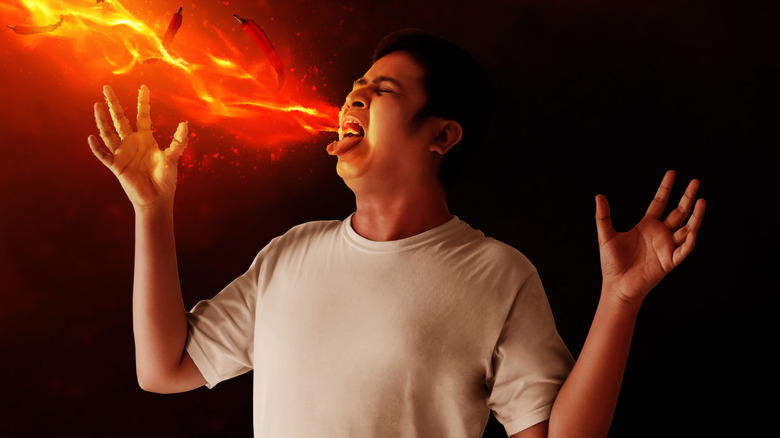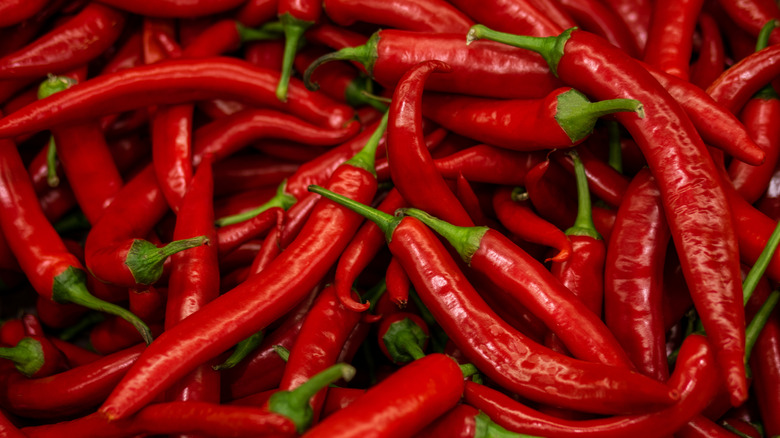The Untold Truth Of The Scoville Scale
The Scoville scale is a convenient way of knowing how hot a specific type of pepper actually is. Creating a pepper that tops the scale can even land you a Guinness World Record. The scale itself was created in 1912 by Wilbur Scoville, an employee of a pharmaceutical company. While the scale's concept has remained the same since its creation, the method for testing pepper heat has changed, as has the list of hottest peppers. The latter has evolved rather rapidly as people aim to see just how much heat the Capsicum genus can hold (via PepperScale).
New hybrids and a potential accidental discovery have taken Scoville scale ratings to new heights much to the delight of pepper fans. If a pepper can be bred that tops the current highest rating, there are sure to be people trying to grow it and market a hot sauce. While food is at the forefront of our interest with spicy peppers these days, ranking chilis based on the amount of heat they add to food was actually not the original purpose behind the rating system. Here's a look at the untold truth of the Scoville scale.
Scoville ratings were originally determined by tasting a diluted mixture
Technology back in 1912 wasn't adequate to measure pepper heat in a laboratory, so Wilbur Scoville relied on actual taste tests. Insider explains that after mixing dried chili powder with alcohol and letting that concoction sit to produce an extract, he mixed it with sugar water. Then, he had people drink the solutions, adjusting the sugar water in standardized amounts until the testers couldn't detect any heat.
The test was called the Scoville Organoleptic Test, and its ratings were based on how diluted the pepper–sugar water mixture had to be in order to make the heat undetectable to the average taster (via FiveThirtyEight). The number of dilutions required to make the perceived heat disappear was termed Scoville Heat Units or SHUs.
This was a highly subjective way to test pepper heat, and the issue of taste fatigue was a potential problem. By tasting spicy extracts, participants could become accustomed to the spiciness, increasing the chances that they would rate hotter peppers more mildly (via NU Sci). This is essentially what happens when you regularly eat large amounts of the same type of hot sauce and eventually begin to lose the burning sensation.
Labs now use chromatography and other objective tests to measure Scoville ratings
Later in the 20th century, scientists devised better ways to investigate the chemical properties of food, including capsaicin, the compound that makes peppers hot. Researchers started using high-performance liquid chromatography (HPLC) to assign a Scoville ranking in the 1980s. At the time, the spiciest pepper on the scale was the habanero, which was sometimes as hot as 350,000 Scoville heat units (via FiveThirtyEight).
As helpful as HPLC has been in determining the heat of a pepper, it's not a perfect process. One complaint is that it doesn't inform you about a pepper's flavor, and instead focuses only on its heat. That means that a chili pepper can be absolutely tasteless or taste like complete garbage without you knowing until you take a bite. Plus, according to Ars Technica, HPLC is expensive and requires trained operators who know exactly what they're doing. Other tests that measure Scoville units using methods such as colorimetry have the same issues. Instead, some labs have started using electrochemical tests which have proved to be pretty accurate.
Many rankings consist of a range rather than a single number
The actual heat of a pepper variety may fluctuate due to a few factors, including which subvariety is being tested, the pepper's maturity, and where it was grown. This means that a particular pepper variety might have a range of SHU values rather than a single number. First, capsaicin levels in individual peppers may be different within the same species simply due to natural variations (via Chili Pepper Madness).
Second, what we think of as one type of pepper might actually be a group of cultivars or species. Hatch chiles, for example, are actually a group of several peppers of varying spiciness grown in the Hatch Valley in New Mexico (via Hatch Chile Store). Third, some pepper plants become hotter or milder as they mature, leading to different ratings. Insider notes that a jalapeño pepper may tone down as it ages, whereas a Madre Vieja gets hotter with maturity.
The peppers may also become hotter in drought conditions, although this is still under investigation. For example, a study from September 2012 published in the journal HortScience, found that capsaicinoids increased in most chili pepper plants subjected to drought stress. On the other hand, a study published in July 2021 in Plants found that the genetic makeup of a hot pepper plant was responsible for capsaicin content, concluding that the topic needed more research.
The Scoville scale may have a new champion pepper
The top spot on the Scoville scale for peppers has changed a handful of times over the past few years as breeders seek ever hotter peppers. You've likely heard of the fiery ghost pepper, aka bhut jolokia, but it has long been surpassed by the Infinity pepper and several varieties of 7 Pot peppers (via PepperScale). Spicier yet are select Naga and Scorpion varieties that push SHU values above 2 million Scoville units.
Meanwhile, the Carolina Reaper is a well-known variety with Scoville units topping 2.2 million. This Pakistani Naga and red habanero hybrid held the top spot for a few years, although Chili Pepper Madness reports that other peppers claiming to be even hotter exist. Currently, the three hottest known peppers are the Dragon's Breath, at 2.48 million SHUs; and Apollo and Pepper X, both hanging out above 3 million SHUs (via PepperScale).
Dragon's Breath may actually have been an accidental creation. BBC reported in 2017 that Welsh grower Mike Smith added a specialized plant food that he obtained from Nottingham Trent University to a pepper plant pot. The combination produced a pepper so spicy that Smith had to store it in a sealed container when he displayed it at the Chelsea Flower Show (via Live Science).
The Scoville scale was created to measure pepper heat for a medicinal ointment
When Wilbur Scoville decided to measure pepper heat, he wasn't motivated by culinary reasons. According to the book "Tasty," by John McQuaid, Scoville was working for the Parke-Davis pharmaceutical company, looking for ways to measure the heat of peppers that could potentially be used in a medicinal heat ointment (via Vox). The company already had an ointment called Heet Liniment, which contained capsaicin and produced a hot sensation and reduced pain when applied to the skin. In order to verify that the amount of capsaicin in the ointment could consistently reproduce the effect, it was necessary to measure the exact levels.
Enter Wilbur Scoville and his Organoleptic test designed to measure capsaicin through a series of taste tests. Unfortunately, Scoville's scale wasn't precise enough to be used for pharmaceutical purposes. Ultimately, the ointment was made using an ingredient obtained from wintergreen mint. However, the scale still proved useful for people wishing to see the relative heat of the peppers they liked eating.
There are people who lack a capsaicin receptor and can't detect much heat
Some people can down extremely hot peppers without flinching, as New Zealand singer Lorde demonstrated on "Hot Ones" by eating wings doused with hot sauce made from some of the hottest peppers on the Scoville scale. According to Scienceline, some people lack the receptor that identifies capsaicin heat. Generally, humans have capsaicin receptors in their mouths and throats, which explains why you feel a burning sensation beyond just your tongue. However, some people win the genetic lottery and have few or no receptors, allowing them to eat anything regardless of spice level (via Scienceline).
High Scoville scores mean nothing to these people, so while they can taste a pepper's flavor, they don't suffer from the burning feeling. Of course, in Lorde's case, the apparent inability to feel the burn from capsaicin (either that, or she had amazing physical control) served her well; the last hot sauce she tried had Scoville-scale-topping Apollo peppers as its base ingredient, and her only reaction was to call it delicious (via YouTube).
The scale has rankings for non-pepper heat
The SHU measure from the Scoville scale can be applied to anything spicy, even if the heat doesn't come from capsaicin in peppers. For example, actual pepper spray is ranked as hot as 5 million SHUs, even though you'd never eat it (via Forbes). And resiniferatoxin, a chemical found in the Moroccan plant called resin spurge, has the top spot at 16 billion SHUs (via Wired). Researchers believe that resin spurge's heat could make it a good ingredient for painkillers.
There have also been unofficial attempts to place Flamin' Hot Cheetos on the Scoville scale as well, because why not? They are estimated to clock in at 50,000 SHUs by Crave DFW, but there's nothing to back that up. Regardless, the spicy snacks are extremely hot, and they may have even landed rapper Lil Xan in the hospital (via Thrillist). The rapper told fans that he thought he ate too many Flamin' Hot Cheetos, but it's more likely that he had existing stomach issues the Cheetos might have exacerbated.
The Scoville rating might not be reflected in a dish
The liquid chromatography test that determines the SHU rating of a chili pepper is accurate in terms of how hot that particular pepper is. However, researchers, growers, and hot sauce makers use different forms of peppers to confirm a SHU rating. In other words, a lab might grind up a dried pepper while a grower might test a fresh pepper. Unfortunately, a fresh pepper has a lot of moisture in it that can dilute the capsaicin, giving a vastly different rating than a test based on a dry pepper might (via FiveThirtyEight).
Furthermore, none of the people or organizations testing the peppers check to see how the actual use might dilute the SHU rating. For example, a ghost pepper chopped up in salsa might not deliver the heat promised by its exact Scoville rating. While a number of people enjoy biting directly into hot peppers just to see if they can handle it, most people ultimately consume peppers in a diluted form.
Super hot peppers have been known to cause hallucinations
The burn from a very hot pepper can enhance food in many cases. But the hotter the pepper, the harder it is to eat because that burn becomes too painful to handle. Dr. Paul Bosland tells Smithsonian Magazine that our brains view the burn from hot peppers as the same type of threat as food or drinks served at hot temperatures.
Researcher John Prescott reports that capsaicin in peppers causes your body to release endorphins to soothe pain (via New Scientist). These are the same feel-good hormones that your body produces when you're exercising, which Johns Hopkins Medicine explains act to reduce muscle pain. Similarly, they can ease the effects of capsaicin on the digestive system.
When your body has that many endorphins running through it, it appears that you could enter a state that might induce hallucinations. In 2013, the Daily Mail reported that a man tried to eat a curry made with 20 Naga Infinity chili peppers, totaling 6 million SHUs. He started hallucinating mid-meal and had to walk away temporarily to get fresh air, but he actually went back and finished the dish.
Currently, Scoville scale ratings are based on pungency units
Despite the disadvantages mentioned of using HPLC to measure SHUs, the American Spice Trade Association (ASTA) still uses HPLC for its ratings (via The Spruce Eats). However, the organization does not initially measure pepper heat in SHUs; instead, it first uses the ASTA pungency unit, which is converted to SHUs per the ratio of 1 ASTA to 15 SHUs. The conversion is approximate and done solely because the Scoville scale is more familiar to people.
Interestingly, until December 1998, ASTA used a standard taste test to measure heat rankings (via Alpha MOS). It was known as ASTA Method 21.0, but it was determined to be subject to too many problems, such as taster's fatigue and an inability to easily reproduce results. In December 1998, ASTA implemented the ASTA Method 21.3 which used HPLC instead. Ultimately, Method 21.0 and other versions were no longer considered valid.
